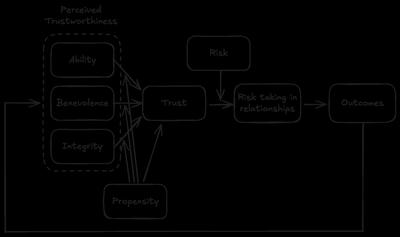The 30-year-old trust formula that still runs the world

“To me, you’re not just Systems Engineers—you are Speaking Engineers. I’ve got plenty of engineers working on great products. However, I need you to speak to customers and earn their trust in our technology.”
That was Scott McNealy, CEO of Sun Microsystems, talking to a room full of technical professionals in the early 2000s. His message was clear: technical excellence isn’t enough. The ability to earn trust separates good engineers from great ones, and determines who moves up the career ladder.
Most of us learned this the hard way.
When superior solutions lose
Alex was furious. All that work, the research, the analysis—for nothing. She’d come to the customer meeting perfectly prepared with the best solution, complete with data and answers to every potential question. Yet that competitor had won the contract with what seemed like casual conversation about Formula One and business gossip.
Their solution wasn’t even that good. If only the customer had let her explain in more depth, they might have realized how superior her approach was.
Sound familiar? In tech, we may think that merit speaks for itself. Build the better solution, present the clearer data, win the deal. Except humans don’t work that way.
The missing component isn’t technical. It’s trust.
The formula that cracked the code
For decades, I thought dealing with people was elusive and impossible to understand. As a tech person, I preferred the predictable logic of hardware and code. Either it works or it doesn’t, and there’s always a way to diagnose the problem.
Then I found out that three researchers had cracked the code 30 years ago. Their paper, An Integrative Model of Organizational Trust, had been hiding in academic journals while people like me struggled with “soft skills.”
The breakthrough was realizing trust isn’t mysterious—it’s systemic. According to the authors, three core components determine whether people trust you:
- Ability: Do you know what you’re doing?
- Benevolence: Do you want good things to happen to the other party?
- Integrity: Are you reliable and do your standards align with theirs?
The trust equation is elegantly simple:
Trust = Ability + Benevolence + Integrity
Here’s the kicker: you can influence all three components! Trust isn’t fixed—it’s trainable.
How your brain processes trust
Think of trust like training a neural network. Just as researchers discovered a “Simpsons neuron” that fires whenever we see a video clip from the TV series, your brain maintains dedicated neural areas for every person you know.
For each relationship, you have metaphorical Ability, Benevolence, and Integrity neurons that get updated with every interaction.
Subconsciously, your brain asks the following questions at every interaction:
- Does this person know their stuff? (Ability assessment)
- Are they on my side? (Benevolence matching)
- Can I predict their behavior? (Integrity check)
As it collects more data during each interaction, it strengthens or weakens these neural connections. The more interactions you have, the stronger these connections become. But there’s a caveat: trust is contextual. Your colleague might be brilliant at infrastructure but you wouldn’t trust them with your medical decisions.
There’s also a fourth component: propensity to trust. It acts like a default bias setting. Some people and cultures trust strangers more readily than others. You can’t control this in others, but knowing it exists helps explain why the same approach works differently with different people.
Earning trust, one component at a time
Trust can’t be faked or manipulated, it must be earned, with every interaction, and it takes time. This is a good thing, because that’s what makes trust work even during the toughest of times. However, you can work towards building more trustful relationships by being more transparent about yourself, and more conscious about how you communicate trust signals.
Ability: show, don’t just tell
Demonstrating competence is straightforward for technical people, but there’s a catch: you have to actually show it. People have finely-tuned BS detectors for spotting someone reading slides versus someone who’s „been there, done that, got the t-shirt.”
When I worked at AWS, I’d introduce myself by saying, “Hi, I’m Constantin, I joined AWS in 2012.” Simple, humble, but powerful. Customers would run the math and realize: this guy had been working with cloud technology for over a decade.
Instead of slides, I preferred live demos. Real-world examples relevant to their industry, complete with true stories about how a simple cron job failure brought down my wife’s business website during a webinar because an SSL certificate didn’t renew. Then I’d show them the custom CloudWatch metric I built to monitor certificate expiration dates.
The key is: authentic experience you can demonstrate on demand trumps the most beautifully designed slide. Building ability takes time and effort, but the dividends are huge. During the last few decades, I learned so much from so many different fields, turning me into an Expert Generalist, opening up many doors in my career.
Benevolence: becoming one with your customer
The best technical knowledge is useless if customers think you’ll use it against them. Car salespeople know more about cars than you do, but they’re famously untrustworthy because they might use that knowledge to sell you a lemon.
You must show you genuinely care about the other party’s success. This takes time, but you can start immediately: show real interest in their challenges, offer specific advice tailored to their situation, share something that shows you’re really on their team.
At AWS customer meetings, I’d mentally take off my “AWS hat” and put on my customer’s. I’d ask questions as if I were a new employee of theirs on my first day. Before visiting, I’d research their company news to find relevant details I could reference. Over time, I naturally started saying “How do we solve this?” where “we” meant me and my customer working together.
Integrity: the foundation everything else rests on
Superior knowledge plus good intentions means nothing without reliable execution. Integrity has two parts: you follow a consistent set of principles, and those principles are acceptable to the other party.
This works like an operational contract. You promise to behave in predictable ways, then you keep those promises consistently. Your values and working style must be compatible with theirs.
Here’s where that seemingly pointless small talk becomes crucial. As an introverted, rational person, I used to hate discussing weather, sports, or random news events. Until I learned about the real purpose of small talk: discovering common things. Shared experiences, values, or backgrounds that signal compatible principles. You both went to the same university? Or worked at the same company before? Then you share the same mental models! You have common interests? That indicates shared values that makes them more familiar, more predictable.
Set realistic expectations about how you work and what others can expect. Make clear promises and deliver against them, every time. Better yet: underpromise and overdeliver. If the unexpected happens, communicate early and often.
I became fascinated with Amazon’s Leadership Principles because they’re public—customers could understand exactly how Amazonians “tick” and what to expect when working with us. This transparency builds the foundation for trust.
When the pattern clicked
Once I understood this model, I could see it everywhere:
Startup funding rounds: VCs evaluate founders on their track record (Ability), whether they’re building something meaningful or just working toward an exit (Benevolence), and whether their numbers are real (Integrity).
AI adoption: Companies debate whether AI models hallucinate (Ability), whether they have hidden agendas from their creators (Benevolence), and how much testing and quality assurance went into training them (Integrity).
Technical leadership transitions: The brilliant engineer who gets promoted to manager has to earn trust from their team all over again. Same person, but now the context has changed.
The examples are endless: family, friendships, media stories, politics, processes, even software APIs and protocols. Once you know what to look for, you begin to decode trust everywhere.
From disaster to transformation
Here’s a trust disaster that still lets my blood freeze: My first customer presentation in 1998 was a complete failure. I was supposed to present Sun’s new server to a group of potential buyers. I studied the specs, memorized speeds and feeds, used the standard slides I was given.
But I missed everything that mattered: I barely introduced myself, had never actually worked with the machine, no idea what customers would use it for beyond “uuh, web server,” and no clue what the audience really wanted to know.
Despite my best technical intentions, I sent zero trust signals. No ability demonstration beyond reading slides, no benevolence signals showing I cared about their problems, no integrity foundation because I hadn’t established who I was or how I got there in the first place. To be clear: I did know my stuff, wanted my customers to succeed, and had high work standards. But I failed to communicate this.
I felt stressed, stammered through the presentation, and was relieved when it ended. But instead of deciding “presenting isn’t for me,” I committed to learning what it takes to earn trust from an audience.
That started two decades of obsessive improvement that eventually led to me coaching dozens of speakers at AWS re:Invent 2024. My first question to every single speaker: “Who is your audience, and what problem are you solving for them?” Going straight into benevolence and ability, with integrity covered through our subsequent delivery preparation.
Alex’s second chance
Six months later, Alex got another shot at a major deal. This time, she approached it differently.
She started the meeting by sharing a brief story about a similar project she’d completed, including the specific challenges she’d faced and how she’d solved them (Ability). She asked thoughtful questions about their business goals and what success would look like for them, genuinely listening to understand their perspective (Benevolence). She was transparent about her approach, timeline, and what they could expect throughout the project (Integrity).
When the time came to present her solution, the customers were already leaning in. They asked detailed questions because they trusted she had the expertise to answer them. They shared more about their constraints because they believed she wanted to help them succeed. They felt confident moving forward because they understood how she worked and what they could expect.
Alex won the deal—not because her technical solution had changed, but because she’d learned to earn trust first.
Your turn: start observing
Here’s the one thing you can do starting tomorrow that will transform your professional relationships: start observing trust signals in others.
Watch your next meeting with fresh eyes. Notice why some people seem more credible, helpful, or reliable than others. What signals are they sending about their ability, benevolence, and integrity? What about the people who seem less trustworthy?
Then observe yourself. What signals are you sending? Are you demonstrating competence or just claiming it? Are you showing genuine interest in others’ success? Are you setting clear expectations and meeting them consistently?
As humans, we’re natural mimics. Simply observing how trust works will help you naturally improve your own trust signals, creating a positive feedback loop.
Trust as competitive advantage
In our increasingly automated world, the ability to earn trust becomes more valuable, not less. Humans trust humans. While AI handles more routine interactions, the real value goes to people who can build genuine connections with other people.
The trust equation gives you a systematic approach to the most important professional skill you can develop. Master this, and you’re not just a better engineer—you’re an engineer others want to work with, promote, and partner with.
The formula is as old as humanity, it has been researched 30 years ago, but it has never been more relevant. In a world of endless technical options, trust is the differentiator that lasts.
Your next meeting is your next opportunity. What trust signals will you send?
